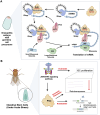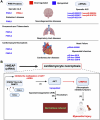Somatic piRNA and PIWI-mediated post-transcriptional gene regulation in stem cells and disease
- PMID: 39717847
- PMCID: PMC11663942
- DOI: 10.3389/fcell.2024.1495035
Somatic piRNA and PIWI-mediated post-transcriptional gene regulation in stem cells and disease
Abstract
PIWI-interacting RNAs (piRNAs) are small non-coding RNAs that bind to the PIWI subclass of the Argonaute protein family and are essential for maintaining germline integrity. Initially discovered in Drosophila, PIWI proteins safeguard piRNAs, forming ribonucleoprotein (RNP) complexes, crucial for regulating gene expression and genome stability, by suppressing transposable elements (TEs). Recent insights revealed that piRNAs and PIWI proteins, known for their roles in germline maintenance, significantly influence mRNA stability, translation and retrotransposon silencing in both stem cells and bodily tissues. In the current review, we explore the multifaceted roles of piRNAs and PIWI proteins in numerous biological contexts, emphasizing their involvement in stem cell maintenance, differentiation, and the development of human diseases. Additionally, we discussed the up-and-coming animal models, beyond the classical fruit fly and earthworm systems, for studying piRNA-PIWIs in self-renewal and cell differentiation. Further, our review offers new insights and discusses the emerging roles of piRNA-dependent and independent functions of PIWI proteins in the soma, especially the mRNA regulation at the post-transcriptional level, governing stem cell characteristics, tumor development, and cardiovascular and neurodegenerative diseases.
Keywords: PIWI; disease; gene regulation; mRNA; piRNA; retrotransposons; stem cells.
Copyright © 2024 Patel, Jiang and Kakumani.
Conflict of interest statement
The authors declare that the research was conducted in the absence of any commercial or financial relationships that could be construed as a potential conflict of interest.
Figures








Similar articles
-
PIWI proteins and piRNAs: key regulators of stem cell biology.Front Cell Dev Biol. 2025 Feb 6;13:1540313. doi: 10.3389/fcell.2025.1540313. eCollection 2025. Front Cell Dev Biol. 2025. PMID: 39981094 Free PMC article. Review.
-
PiWi RNA in Neurodevelopment and Neurodegenerative Disorders.Curr Mol Pharmacol. 2022;15(3):517-531. doi: 10.2174/1874467214666210629164535. Curr Mol Pharmacol. 2022. PMID: 34212832 Review.
-
piRNA/PIWI pathways and epigenetic crosstalk in human diseases: Molecular insights into HIV-1 infection and drugs of abuse.Mol Ther Nucleic Acids. 2025 Feb 1;36(1):102473. doi: 10.1016/j.omtn.2025.102473. eCollection 2025 Mar 11. Mol Ther Nucleic Acids. 2025. PMID: 40083650 Free PMC article. Review.
-
Emerging roles and functional mechanisms of PIWI-interacting RNAs.Nat Rev Mol Cell Biol. 2023 Feb;24(2):123-141. doi: 10.1038/s41580-022-00528-0. Epub 2022 Sep 14. Nat Rev Mol Cell Biol. 2023. PMID: 36104626 Review.
-
PIWI Proteins and PIWI-Interacting RNA: Emerging Roles in Cancer.Cell Physiol Biochem. 2017;44(1):1-20. doi: 10.1159/000484541. Epub 2017 Nov 3. Cell Physiol Biochem. 2017. PMID: 29130960 Review.
Cited by
-
Patterns of Circulating piRNAs in the Context of a Single Bout of Exercise: Potential Biomarkers of Exercise-Induced Adaptation?Noncoding RNA. 2025 Jun 16;11(3):46. doi: 10.3390/ncrna11030046. Noncoding RNA. 2025. PMID: 40559624 Free PMC article.
-
Targeting Regulatory Noncoding RNAs in Human Cancer: The State of the Art in Clinical Trials.Pharmaceutics. 2025 Apr 4;17(4):471. doi: 10.3390/pharmaceutics17040471. Pharmaceutics. 2025. PMID: 40284466 Free PMC article. Review.
References
Publication types
LinkOut - more resources
Full Text Sources
Molecular Biology Databases

